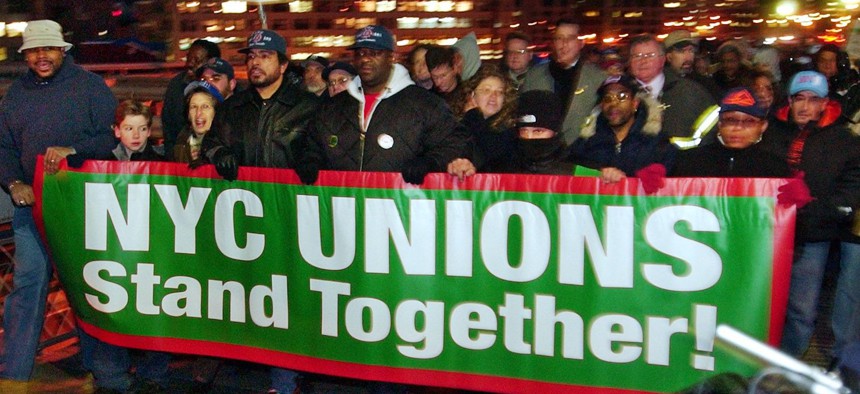Labor
New York City’s history of public sector strikes
Despite a 1967 law making strikes illegal, there have been several prominent strikes by transit workers and teachers.

Transit workers march across the Brooklyn Bridge, in New York for a rally on the steps of City Hall in December 2002. Kathy Willens/AP/Shutterstock
New York City has managed to avert a major teachers union strike for now, coming to a deal that will delay the start of in-person learning by more than a week. If the strike had happened, it would’ve been the first strike by New York City teachers in 45 years. The rarity of strikes from public sector employees isn’t surprising given that New York’s Taylor Law makes it illegal for them to walk off the job – but that hasn’t necessarily stopped unions from doing so since the law went into effect in 1967. Here are some of the instances when public sector employees went on strike in New York City.
2005 transit strike
As negotiations on pensions broke down between the Metropolitan Transportation Authority and the Transport Workers Union Local 100 in December 2005, union officials announced a strike. Workers on New York City’s subways and buses walked off the job, stalling the transit system and leaving commuters scrambling to find other ways to get to work. Union leaders eventually pulled back on the strike without arriving at a deal amid pressures of lost pay for individual workers, and fines and threats of jail time for officials. Even the union’s international president called for an end to the strike. The union eventually had to pay a $2.5 million fine and suspend the automatic payroll deduction of union dues from workers for 90 days because of the illegal strike, and TWU Local 100 President Roger Toussaint was sentenced to 10 days in jail and had to pay a $1,000 fine.
1980 transit strike
The 2005 strike wasn’t the first time transit workers walked off the job. In fact, a 1966 transit strike in part led to the creation of the Taylor Law. But that didn’t stop workers from going on strike in 1980, as the Transport Workers Union Local 100 aimed to build pressure for a wage increase. While the 2005 strike had the transit system slowed down for three days, transit workers walked out for 11 days during their strike that began on April 1, 1980. Union leaders and the MTA eventually came to a deal that gave a greater pay increase to workers, but it came at a cost for the union and the city. The transit union had to pay $1.25 million in penalties because of the strike and workers were docked pay for the 11 days that they weren’t working. And contending with the new labor agreement and a widening deficit, the transit authority raised the fare from 50 to 60 cents.
1975 teachers strike
With the backdrop of a worsening fiscal crisis in the city, the United Federation of Teachers balked at teachers being laid off, leaving the remaining educators to contend with larger class sizes in 1975. Tens of thousands of teachers started the school year by walking out for five days, causing school closures and keeping students at home. The union managed to mitigate some of that tension with the city later that year, however, by saving New York City from bankruptcy after investing $150 million from the Teachers’ Retirement System into city bonds.
1968 teachers strike
Tensions began in an Ocean Hill-Brownsville school district in Brooklyn, when a community school board laid off teachers and school officials in May 1968. The experimental school board was part of the city’s effort to decentralize control of the education system, as communities of color pushed for more local control of their schools. But the layoffs of mostly white and Jewish educators in the predominantly Black district drew the ire of the United Federation of Teachers on the basis of job security and due process. The teachers union escalated strikes early in the school year to build pressure to rehire the teachers or even have the district be taken over by the state. Racial tensions between the neighborhood’s largely Black and Latino population and the union’s predominantly white and Jewish members were heightened during the strikes. Eventually, the union’s demands were heard as a state trustee began to oversee the district and the teachers were reinstated.
NEXT STORY: Why New York City delayed school reopening

